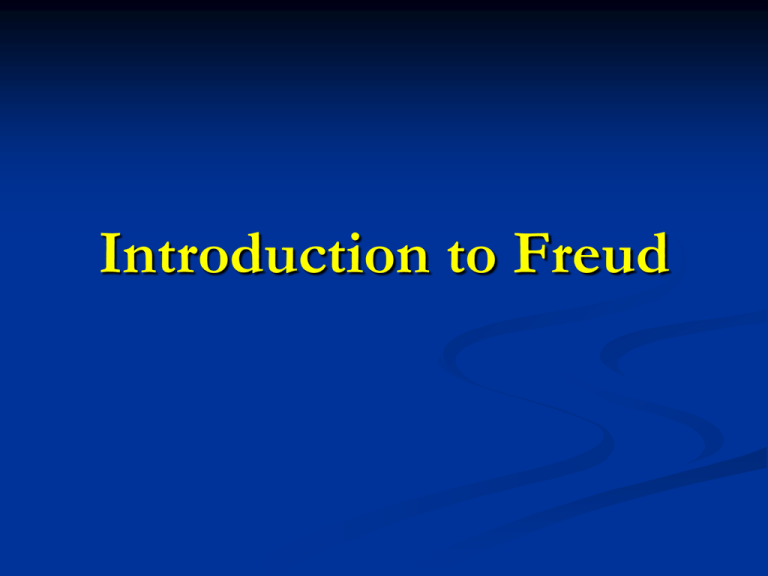Introduction to Freud Id, Ego, Superego
advertisement

Introduction to Freud Part I: The Topographical Model Sigmund Freud (1856–1939) was an Austrian neurologist who became known as the founding father of psychoanalysis. He’s considered one of the most influential thinkers of the 20th Century. Freud’s first theory of identity is referred to as a Topographical or Conflict Model Part I: The Topographical Model Topographical Conflict Model The self is not unified. It is not a coherent, singular entity. Not entirely rational, not entirely in control of itself. There are competing elements within ourselves. No way to resolve competing elements – the only way to stay healthy is not to let any one of them “get the upper hand” or sickness (neurosis or psychosis) can occur. Part I: The Topographical Model Sigmund Freud’s conflict model is based on the idea of the id, the ego, and the superego. These are the components of the self. Freud describes the human personality as a battlefield: “He [a human] is a dark-cellar in which a well-bred spinster lady (the superego) and a sex-crazed monkey (the id) are forever engaged in mortal combat, the struggle being refereed by a rather nervous bank clerk (the ego).” Part I: The Topographical Model The Id “Id” is Latin for “it”. Irrational, emotional, demanding, strong The source of all selfish desires as it tries to satisfy basic bodily, sexual, and aggressive drives Does not care about others or the reality of the situation The oldest part of our mind – most primal, most primitive, since it precedes learned culture Part I: The Topographical Model The id is ruled by what Freud called the pleasure principle. According to the pleasure principle, the id cares only about immediate self-gratification; it doesn’t care about others or the circumstances (reality) of the situation. The id is sometimes represented by a devil sitting on someone’s shoulder. As this devil sits there, it tells the ego to base behavior on how the action will influence the self, specifically how it will bring pleasure to the self. Part I: The Topographical Model The Superego Latin for “above the I” The moral part of the mind—the conscience— since the ego is not necessarily moral Represents social and parental values that step in when mom or the cops aren’t around Sometimes represented by an angel sitting on someone’s shoulder, telling the ego to base behaviors on the rules and how the actions will affect others or influence society Part I: The Topographical Model The Ego Latin for “I” The part of the personality that maintains a balance between our impulses (our id), our conscience (our superego), and reality. Represented by a person, with a devil (the id) on one shoulder and an angel (the superego) on the other Part I: The Topographical Model The ego is ruled by the reality principle and is more pragmatic: “You can’t always get what you want.” The ego understands that other people have needs and desires and that sometimes being impulsive or selfish (i.e. acting on the id’s desires) can hurt us in the end. It is the ego’s job to meet the needs of the id, while taking into consideration the reality of the situation (including moral consequences). The ego works, in other words, to balance the id and superego. Part I: The Topographical Model The ego is in service to the id, yet it uses some of the id’s psychic energy to control the id by reasonably satisfying the id. Over time, the ego becomes pretty good at this and develops a large vocabulary of methods for keeping the id gratified without provoking the superego. In other cases, the ego uses repression to suppress and forget its instinctual or id-oriented impulses. Part I: The Topographical Model Part I: Id, Ego, Superego If, as an adult, your id is too dominant, you are very self-absorbed, don’t care about others, and are only out for yourself. If, as an adult, your ego is too dominant, you are distant, rational, efficient, unemotional, or cold. If, as an adult, your superego is too dominant, you are guilt-ridden or sanctimonious (i.e. telling everyone else what’s right or wrong all the time). Part II: Psychoanalytic Model of Identity The Iceberg Model of the Mind Part II: Psychoanalytic Model of Identity Conscious Mind The tip of the iceberg Smallest part: 10% of the mind. We can access this. We are aware of this part of “us.” We understand it logically. Part II: Psychoanalytic Model of Identity Preconscious Mind Middle of iceberg Medium size: 10-15% of the mind. Ordinary memory. You don’t keep a lot of information in your preconscious mind all the time. If you need to remember something (where you parked your car) you can bring it “up” to your conscious mind. Part II: Psychoanalytic Model of Identity The Unconscious Mind Bottom of iceberg Huge: 75-80% of our mind. Not directly available to the conscious mind, since it’s “underwater”. Plays a very large role in how we function as human beings. Most of the work among the id, ego, and superego occurs here. Part II: Psychoanalytic Model of Identity The Unconscious Mind A dumping ground for all of our desires, anxieties, memories, especially those which are painful. Nothing in the unconscious goes away. Even if we aren’t aware of it, what is in the unconscious influences us every day in every way. Can’t directly or easily access the unconscious with the conscious mind. It speaks a different language, using dreams and free association, for example. Part II: Psychoanalytic Model of Identity Psychoanalysis Therapy is the “talking cure” that investigates how the conscious mind interacts with the unconscious mind. When we don’t want to deal with a fear, memory, or desire, the ego represses or hides it in the unconscious mind, which can result in neuroses and psychoses. The psychoanalyst uses techniques to unbury the repressed, unconscious forces that the ego has lost control over in its attempts to ignore them. Part II: Psychoanalytic Model of Identity Literary critics sometimes analyze the actions of literary characters using the three personality structures that Freud identified. As critics explore the ego, superego, and id of characters in a work—along with their unconscious forces—they focus on the ways that these parts of the characters’ personalities influence the work as a whole. The author’s works can serve as “dreams” that reveal identity. This interpretive lens is called psychoanalytic criticism. Part II: Psychoanalytic Model of Identity Consider how Freud’s topographical and psychoanalytical models of the mind can provide insight into what is happening in Lord of the Flies.









